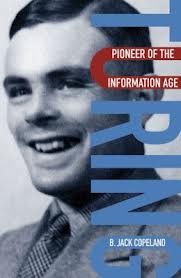 Turing: Pioneer of the Information Age
Turing: Pioneer of the Information Age
by B. Jack Copeland
Oxford University Press
224 pages, $21.95
THERE MAY STILL BE some lingering debate over who was the true “father of the computer,” but Jack Copeland places himself decisively with those who favor British mathematician Alan Turing, who laid the groundwork for a universal machine, the stored-program device that led to most of the computers we use today. The author, professor of philosophy at the University of Canterbury in New Zealand, where he directs the on-line Turing Archive for the History of Computing, has written and edited several books on this subject.
Born in 1912, Alan Turing was a graduate of English public schools and King’s College, Cambridge, and he earned a doctorate in mathematics at Princeton University. While still in his twenties, he became the chief scientific figure at Bletchley Park, the center of Britain’s decryption efforts during World War II. He’s credited with enabling an Allied naval victory by cracking the Enigma code used by the Germans to carry out U-boat attacks on merchant ships, and by designing a machine to dramatically speed up decryption. He also devised the first systematic method for cracking the vastly more complex code used by the Germans’ Tunny machine, which Copeland tartly terms “Hitler’s Blackberry.”
The author ranks Turing with Churchill and Eisenhower for the value of his wartime contributions, yet the young scientist’s achievements had only begun. Turing’s methodology for cracking code became the basis for algorithms used by the first large-scale electronic computer, the Colossus. He designed a stored-program electronic computer, the huge Automatic Computer Engine or ACE, forerunner of today’s personal computers, and wrote the manual for the “Baby,” the first stored-program computer to actually get built. Turing wrote the first artificial intelligence computer program—one that played chess—and at the time he died was exploring the question of how organisms develop their form.
In 1951, Turing was elected a Fellow of the Royal Society, a signal honor and mark of his brilliance. In spite of the mathematician’s patriotic service, and notwithstanding his ongoing work, Turing was arrested in early 1952 for committing acts with other men that were considered immoral and were in fact illegal, and was required to undergo chemical castration. He died of cyanide poisoning at the age of forty-one, possibly in response to this odious treatment.
Interest in Turing’s life and achievements has been growing ever since, resulting, for example, in Hugh Whiteside’s play and later BBC production Breaking the Code and the 2011 documentary film Codebreaker. Four years ago, British Prime Minister Gordon Brown issued an apology for the government’s “inhumane” treatment of Alan Turing and others convicted under Great Britain’s homophobic laws. Last July, the government signaled its support for a bill introduced in Parliament that would quash Turing’s 1952 conviction for “gross indecency,” essentially granting him a posthumous pardon. Writings about Turing underscore his shy genius, inventiveness, humor, and dedication. His life has been recounted in biographies by his mother, Sara Turing (1959), and by mathematician Andrew Hodges (1983), whose biography was reissued last year for the centenary of Turing’s birth. More recent publications include John Prager’s philosophical monograph (2001) and David Leavitt’s more personal profile (2006).
What does this new biography add to the mix? Copeland’s book is written for those who use computers but may not know much about computer theory. The author’s tone is logical and conversational. He gleaned much of his material from talking with Turing’s colleagues and by listening to their taped interviews, all meticulously cited. Using now-declassified material, he enlarges the picture of what Turing achieved as a mathematical genius, but he also examines the circumstances surrounding Turing’s death and offers a fresh perspective on that tragedy.
Copeland highlights how intense Turing was, how much a “hacker” in the sense of having a life-dominating passion for programming. From his seminal thesis, “On Computable Numbers” (1936), to his later paper, “Computing Machinery and Intelligence” (1950), Turing explored the possibilities for what we now know as computers, and he came up with ways to reach those barely imagined goals. For example, Turing is credited with being first to recognize the potential of storing instructions inside a computer, rather than wiring them into the computer’s hardware, thus broadening the range of problems that a computer could solve while decreasing the time and cost involved in shifting from one kind of problem-solving to another.
Turing wrestled with notions of artificial intelligence. To answer the question whether machines would ever be able to “think,” he devised what became known as the “Turing Test.” In this trial, an observer asks questions of two unseen respondents, one human, the other a machine. If the observer cannot distinguish the human’s replies from the computer’s, the latter is judged to have met the test. Shortly before he died, Turing had begun investigating the patterns by which cellular life arises, what he called “morphogenesis” and today is sometimes termed “artificial life.” To do this, he simulated growing tissue using one of the early computers, foreshadowing later work in neural networks and computer-generated life forms.
Copeland makes adroit use of detail to clarify technical processes. To explain how Turing went from deciphering Enigma codes to creating code-breaking procedures and devices, for example, the author provides photographs of the Enigma machine and illustrations of how it worked. For example, the figure “How the Tunny machine encrypts a letter” shows how text would be entered as letters at a keyboard, move through the motor wheel assembly, and emerge as cyber text for radio broadcast. Copeland’s explanations are straightforward and lively, as when he describes how Turing hit on the idea of programming a universal machine to play musical notes after hearing its troubleshooting alarm beep. Turing’s program led to computer-generated musical notes being heard in the Manchester Computing Laboratory at the end of 1950—seven years before Bell Labs would produce what they claimed was the first computer music!
The author is careful to draw conclusions only when warranted by the evidence, and this caution bolsters his claims for Turing’s pioneering role. He examines the circumstances around Turing’s death with the same attention, raising questions based on gaps in critical information. Turing died the night of June 7, 1954. An autopsy showed he died of cyanide poisoning. Copeland does not dispute this finding, but he does question a common belief that Turing must have taken his own life by biting into a poisoned apple. He states that poisoning could also have resulted from murder or accident, then weighs the evidence for all three hypotheses.
The evidence for suicide seems slender. Among other omissions, the apple found next to Turing’s bed was not tested for cyanide. Further, the coroner held his inquest only two days after Turing died. Without looking into either the deceased’s intentions or his general state of mind, the coroner proceeded to rule the death a suicide. “In a man of this type,” he is quoted as telling a reporter at the time, “one never knows what his mental processes are going to do next,” a statement that raises questions about the coroner’s openness of mind.
The author next examines the evidence for murder, an explanation he says is plausible, but barely. Computers were being used for encryption and for atomic weapons calculations in the Cold War era, and Turing was in effect “overlord of the Allied crypto-world.” However, although British security services sometimes tracked Turing and his friends, Copeland says there is little evidence to support a hypothesis that he was assassinated.
That leaves accident, the explanation favored by Sara Turing. According to comments by friends and colleagues, Turing was in good spirits in the days before he died, spending time with a neighbor’s family and jotting down calendar plans. He was also fussing around in his home lab, gold plating an old spoon, one of many hands-on processes he enjoyed. In this case, the process was electrolysis, which involves cyanide, and cyanide was found bubbling in a pan next to his bedroom. Is it possible that Turing unwittingly inhaled enough fumes to cause his death?
Copeland argues that we should not assume that Turing took his own life, because we don’t really know how he died. What matters more is that his extraordinary achievements are being recognized—along with the injustice that was done. What emerges most forcefully is the complexity of Alan Turing, a genius whose amazing insights led to the construction of the social network that links much of today’s world—but whose unconventionality and introversion led to his being largely unrecognized and shamefully wronged. In his lifetime, Turing demonstrated modesty and exceptional courage, and his life story continues to inspire biographers such as Copeland to find out what made him tick.
Rosemary Booth is a writer and photographer living in Cambridge, Mass.





